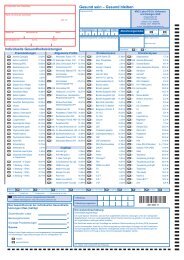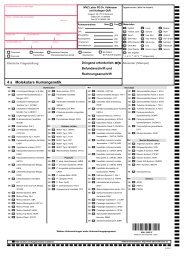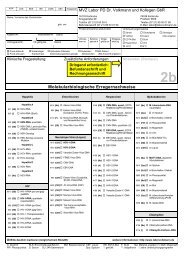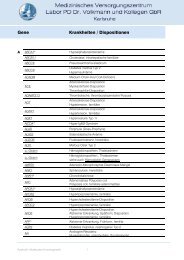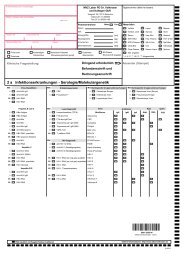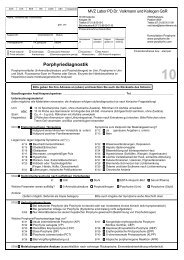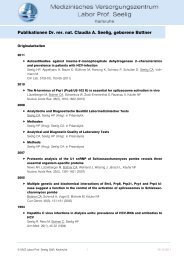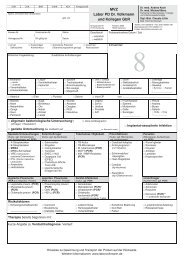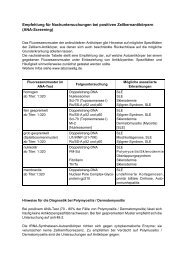ORIGINAL ARTICLE - MVZ Labor PD Dr. Volkmann und Kollegen
ORIGINAL ARTICLE - MVZ Labor PD Dr. Volkmann und Kollegen
ORIGINAL ARTICLE - MVZ Labor PD Dr. Volkmann und Kollegen
You also want an ePaper? Increase the reach of your titles
YUMPU automatically turns print PDFs into web optimized ePapers that Google loves.
H. P. SEELIG et al.<br />
Figure 2. Radioimmunoprecipitation of 35 S-methionine labeled HEp-2 cell proteins by the serum of the index patient (lanes 3,<br />
4) precipitating a substantial amount of a 55 kDa protein. Control sera from two healthy blood donors (lanes 1, 2) and from<br />
two patients harboring antibodies against threonyl tRNA synthetase (PL7) with a calculated molecular weight of 82.1 kDa<br />
(lanes 5, 6). SDS page followed by autoradiography for 24 hours.<br />
mycophenolic acid to the cell cultures (Figure 1e). Because<br />
of the suspected prevalence of anti-IM<strong>PD</strong>H2 antibodies<br />
in patients with HCV infections and the therapeutic<br />
use of another IM<strong>PD</strong>H2 inhibitor, ribavirin, in<br />
these patients, we were also interested, whether ribavirin<br />
can cause an identical rearrangement of cytoplasmic<br />
IM<strong>PD</strong>H2. As can be seen from Figure 1f, ribavirin in<br />
concentrations of therapeutic serum levels (16.38 µmol)<br />
also induces a prompt rearrangement of IM<strong>PD</strong>H2 in<br />
“rods and rings” in cultivated HEp-2 cells studied 24<br />
hours after addition.<br />
Evaluation of possible assays for detection of anti-<br />
IM<strong>PD</strong>H2 in human sera<br />
Searching for an appropriate assay for screening of anti-<br />
IM<strong>PD</strong>H2 in human sera, the following approaches were<br />
followed:<br />
First, His(6)-tag-IM<strong>PD</strong>H2, synthesized in E. coli and<br />
affinity purified on Ni2 + -agarose was used for western<br />
and line blots. Second, full length 35 S-methionine labeled<br />
IM<strong>PD</strong>H2 was synthesized by in vitro transcripttion/translation<br />
and applied in RIPA.<br />
As shown by SDS-PAGE (Figure 3a, lane A) the purity<br />
of His(6)-tag-IM<strong>PD</strong>H2 was >95 %, comparable to that<br />
of a commercially available recombinant enzyme. The<br />
electrophoretic mobility corresponded well with the calculated<br />
molecular weight of 55 kDa.<br />
758<br />
Blotted on nitrocellulose (Figure 3a, lanes 1 - 9),<br />
His(6)-tag-IM<strong>PD</strong>H2 was reactive with the index patient’s<br />
serum (lane 5), rabbit anti-IM<strong>PD</strong>H2Si (lane 7),<br />
rabbit anti-IM<strong>PD</strong>H2ih (lane 8) and rabbit anti-His(6)-tag<br />
(lane 9) but not with sera of three healthy blood donors<br />
(lanes 1 - 3) and a serum of a HCV-RNA positive but<br />
IIFT negative patient (lane 4). As compared to the index<br />
patient (lane 5), the serum of one of the four HCV-RNA<br />
positive patients (lane 6) exhibiting the same two-tiered<br />
immunofluorescence pattern, suggestive of anti-IM<strong>PD</strong>-<br />
H2, showed a rather weak reactivity irrespective of IIFT<br />
antibody titer comparable to that of the index serum<br />
(1:1280). Identical results were obtained with a commercial<br />
IM<strong>PD</strong>H2 preparation, except for a missing reaction<br />
with anti-His(6)-tag. The disparity of reaction<br />
strength of the index serum and that of the HCV-RNA<br />
positive patient seen in Figure 3a (lanes 5, 6) is also re-<br />
lated to the recombinant commercial antigen lacking the<br />
His(6)-tag.<br />
Applying this kind of western blot for screening of anti-<br />
IM<strong>PD</strong>H2 in 108 HCV-RNA positive patients only one<br />
borderline and two weakly positive reacting sera could<br />
be detected. As revealed by IIFT and RIPA (vide infra)<br />
one of these two sera (Figure 3a, line 6) showed the<br />
typical anti-IM<strong>PD</strong>H2 immunofluorescence pattern (titer<br />
1:1280) and a positive RIPA (ABR 87.7). The second<br />
serum and the borderline one, however, were nonreac-<br />
Clin. Lab. 9+10/2011



